
Rahab was, according to the Book of Joshua, a Gentile woman who lived in Jericho in the Promised Land and assisted the Israelites by hiding two men who had been sent to scout the city prior to their attack. In the New Testament, she is lauded both as an example of a saint who lived by faith, and as someone "considered righteous" for her works. According to bibical research, the author intended that she did not actually contribute in conquering the city, but rather saved herself and her family from death by the Isralites forces.

In the Book of Genesis, Tamar was the daughter-in-law of Judah (twice), as well as the mother of two of his children: the twins Perez and Zerah.
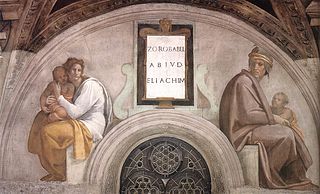
Matthew 1:13 is the thirteenth verse of Matthew 1 of the Gospel of Matthew in the New Testament. The verse is part of the section where the genealogy of Joseph, the father of Jesus, is listed. This verse covers the section somewhat after the Babylonian Captivity six generations before Jesus.
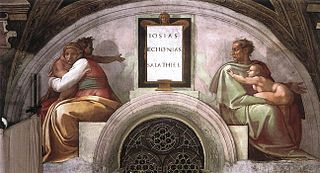
Matthew 1:12 is the twelfth verse of the first chapter of the Gospel of Matthew in the New Testament. The verse is part of the section where the genealogy of Joseph, the betrothed of Mary, the mother of Jesus Christ, is listed.

Matthew 1:11 is the eleventh verse of the first chapter of the Gospel of Matthew in the New Testament. The verse is part of the section where the genealogy of Joseph, the father of Jesus, is listed. It is the last verse of the middle third of the listing.
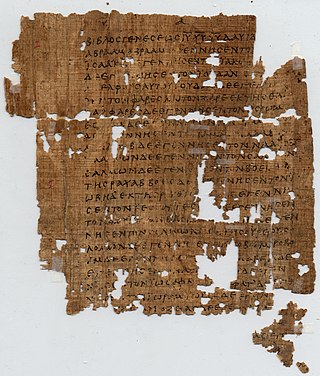
Matthew 1 is the first chapter of the Gospel of Matthew in the New Testament. It contains two distinct sections. The first lists the genealogy of Jesus from Abraham to his legal father Joseph, husband of Mary, his mother. The second part, beginning at verse 18, provides an account of the virgin birth of Jesus Christ.

Matthew 1:8 is the eighth verse of the first chapter of the Gospel of Matthew in the New Testament. The verse is part of the section where the genealogy of Joseph, the legal father of Jesus, is listed.

Matthew 1:9 is the ninth verse of the first chapter of the Gospel of Matthew in the Bible. The verse is part of the non-synoptic section where the genealogy of Joseph, the legal father of Jesus, is listed, or on non-Pauline interpretations the genealogy of Jesus. The purpose of the genealogy is to show descent from the line of kings, in particular David, as the Messiah was predicted to be the son of David, and descendant of Abraham.

Matthew 1:7 is the seventh verse of the first chapter of the Gospel of Matthew in the New Testament. The verse is part of the section where the genealogy of Joseph, the legal father of Jesus, is listed.
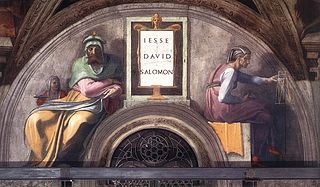
Matthew 1:6 is the sixth verse of the first chapter of the Gospel of Matthew in the New Testament. The verse is part of the section where the genealogy of Joseph, the legal father of Jesus, is listed.

The New Testament provides two accounts of the genealogy of Jesus, one in the Gospel of Matthew and another in the Gospel of Luke. Matthew starts with Abraham and works forwards, while Luke works back in time from Jesus to Adam. The lists of names are identical between Abraham and David, but differ radically from that point. Matthew has twenty-seven generations from David to Joseph, whereas Luke has forty-two, with almost no overlap between them or with other known genealogies. They also disagree on who Joseph's father was: Matthew says he was Jacob, while Luke says he was Heli.

Matthew 1:5 is the fifth verse of the first chapter in the Gospel of Matthew in the New Testament. The verse is part of the section where the genealogy of Joseph, the legal father of Jesus, is listed.
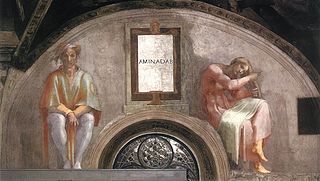
Matthew 1:4 is the fourth verse of the first chapter in the Gospel of Matthew in the New Testament. The verse is part of the section where the genealogy of Joseph, the legal father of Jesus, is listed.

Matthew 1:2 is the second verse of the first chapter in the Gospel of Matthew in the New Testament. The verse is the first part of the section where the genealogy of Joseph, the legal father of Jesus, is listed.

Matthew 1:14 is the fourteenth verse of the first chapter of the Gospel of Matthew in the New Testament. The verse is part of the section where the genealogy of Joseph, the father of Jesus, is listed.
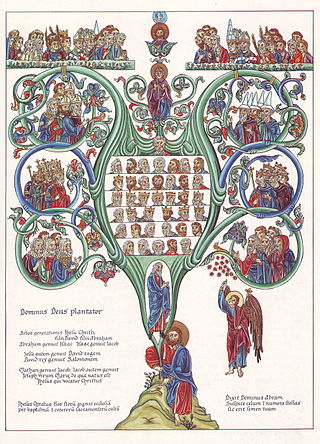
Matthew 1:17 is the seventeenth verse of the first chapter in the Gospel of Matthew in the New Testament. The verse is the conclusion to the section where the genealogy of Joseph, the step-father of Jesus, is listed.

Matthew 1:15 is the fifteenth verse of the first chapter of the Gospel of Matthew in the New Testament. The verse is part of the section where the genealogy of Joseph, the father of Jesus, is listed.

Matthew 1:21 is the twenty-first verse of the first chapter in the Gospel of Matthew in the New Testament. Joseph is being spoken to in a dream by an angel. In this verse, the angel tells Joseph to call the child "Jesus", "because he will save his people from their sins".
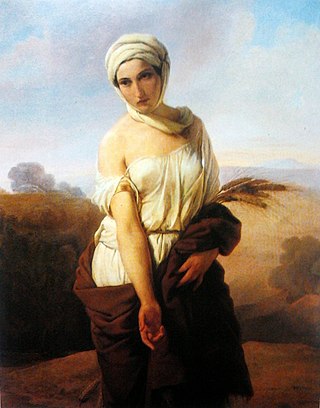
Ruth is the person after whom the Book of Ruth is named. She was a Moabite woman who married an Israelite. After the death of all the male members of her family, she stays with her mother-in-law, Naomi, and moves to Judah with her, where Ruth wins the love and protection of a wealthy relative, Boaz, through her kindness. She is the great-grandmother of David.




















